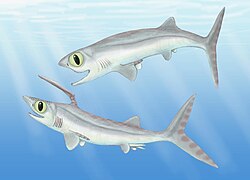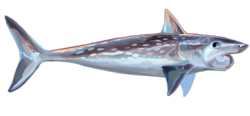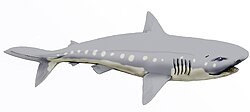Pre Devonian: Origin of fish
| Cambrian | Cambrian (541–485 Ma): The beginning of the Cambrian was marked by the Cambrian explosion, the sudden appearance of nearly all of the invertebrate animal phyla (molluscs, jellyfish, worms and arthropods, such as crustaceans) in great abundance. The first vertebrates appeared in the form of primitive fish, which were subsequently greatly diversified in the Silurian and Devonian. | |||||
|---|---|---|---|---|---|---|
| | Pikaia |
Although Pikaia is not actually "first vertebrate" or "first fish", this is still an important organism to show the early forms of chordates. Pikaia is a genus that appeared about 530 Ma during the Cambrian explosion of multicellular life. It is traditionally considered as transitional fossil between invertebrates and vertebrates, [3] and considered as stem-group chordate in 2012. [4] [5] It was a primitive creature with no evidence of eyes, without a well defined head, and less than 2 inches (5.1 centimetres) long. Pikaia was a sideways-flattened, leaf-shaped animal that swam by throwing its body into a series of S-shaped, zig-zag curves, similar to movement of snakes. Fish inherited the same swimming movement, but they generally have stiffer backbones. It had a pair of large head tentacles and a series of short appendages, which may be linked to gill slits, on either side of its head. The flattened body is divided into pairs of segmented muscle blocks, seen as faint vertical lines. The muscles lie on either side of a flexible structure resembling a rod that runs from the tip of the head to the tip of the tail. [6] | ||||
 | Haikouichthys | Haikouichthys (fish from Haikou) is a genus that also appears in the fossil record about 530 Ma, and marks the transition from invertebrate to vertebrates. [7] Haikouichthys is craniates (animals with backbones and distinct heads). Unlike Pikaia, they had eyes. They also had a defined skull and other characteristics that have led paleontologists to label it a true craniate, and even to be popularly characterized as one of the earliest fishes. Cladistic analysis indicates that the animal is probably a basal chordate or a basal craniate; [8] but it does not possess sufficient features to be included uncontroversially even in either stem group. [9] [7] | ||||
| | Myllokunmingia | Myllokunmingia is a genus that appeared about 530 Ma. It is a chordate, and it has been argued that it is a vertebrate, [10] It is 28 mm long and 6 mm high, and is among the oldest possible craniates. | ||||
 | Conodont | Conodonts (cone-teeth) resembled primitive eels. They appeared 495 Ma and were wiped out 200 Ma. [11] Initially they were known only from tooth-like microfossils called conodont elements. These "teeth" have been variously interpreted as filter-feeding apparatuses or as a "grasping and crushing array". [12] Conodonts ranged in length from a centimeter to the 40 cm Promissum . [12] Their large eyes had a lateral position of which makes a predatory role unlikely. The preserved musculature hints that some conodonts (Promissum at least) were efficient cruisers but incapable of bursts of speed. [12] In 2012 researchers classify the conodonts in the phylum Chordata on the basis of their fins with fin rays, chevron-shaped muscles and notochord. [13] Some researchers see them as vertebrates similar in appearance to modern hagfish and lampreys, [14] though phylogenetic analysis suggests that they are more derived than either of these groups. [15] | ||||
 | Ostracoderms | Ostracoderms (shell-skinned) are any of several groups of extinct, primitive, jawless fishes that were covered in an armour of bony plates. They appeared in the Cambrian, about 510 million years ago, and became extinct towards the end of the Devonian, about 377 million years ago. Initially Ostracoderms had poorly formed fins, and paired fins, or limbs, first evolved within this group. They were covered with a bony armour or scales and were often less than 30 cm (12 in) long. | ||||
| Ordov- ician | Ordovician (485–443 Ma): Fish, the world's first true vertebrates, continued to evolve, and those with jaws (Gnathostomata) may have first appeared late in this period. Life had yet to diversify on land. | |||||
 | Arandaspis | Arandaspis are jawless fish that lived in the early Ordovician period, about 480–470 Ma. It was about 15 cm (6 in) long, with a streamlined body covered in rows of knobbly armoured scutes. The front of the body and the head were protected by hard plates with openings for the eyes, nostrils and gills. Although it was jawless, Arandaspis might have had some moveable plates in its mouth, serving as lips, sucking in food particles. The low position of its mouth suggests it foraged the ocean floor. [16] It is not known how its trunk and caudal fin looked like. [17] | ||||
 | Astraspis | Astraspis (star shield) is an extinct genus of primitive jawless fish related to other Ordovician fishes, such as Sacabambaspis and Arandaspis . Fossils show clear evidence of a sensory structure (lateral line system). The arrangement of these organs in regular lines allows the fish to detect the direction and distance from which a disturbance in the water is coming. Arandaspis are thought to have had a mobile tail covered with small protective plates and a head region covered with larger plates. A specimen described by Sansom et al. had relatively large, lateral eyes and a series of eight gill openings on each side. [18] | ||||
| | Pteraspidomorphi | Pteraspidomorphi is an extinct class of early jawless fish. The fossils show extensive shielding of the head. Many had hypocercal tails to generate lift to increase ease of movement through the water for their armoured bodies, which were covered in dermal bone. They also had sucking mouth parts and some species may have lived in fresh water. | ||||
| Thelodonts | Thelodonts (nipple teeth) are a class of small, extinct jawless fishes with distinctive scales instead of large plates of armour. There is debate over whether these represent a monophyletic grouping, or disparate stem groups to the major lines of jawless and jawed fish. [19] Thelodonts are united by their characteristic "thelodont scales". This defining character is not necessarily a result of shared ancestry, as it may have been evolved independently by different groups. Thus the thelodonts are generally thought to represent a polyphyletic group. [20] If they are monophyletic, there is no firm evidence on what their ancestral state was. [21] These scales were easily dispersed after death; their small size and resilience makes them the most common vertebrate fossil of their time. [22] [23] The fish lived in both freshwater and marine environments, first appearing during the Ordovician, and perishing during the Frasnian–Famennian extinction event of the Late Devonian. They were predominantly deposit-feeding bottom dwellers, although some species may have been pelagic. | |||||
| The Ordovician ended with the Ordovician–Silurian extinction event (450–440 Ma). Two events occurred that killed off 27% of all families, 57% of all genera and 60% to 70% of all species. [24] Together they are ranked by many scientists as the second largest of the five major extinctions in Earth's history in terms of percentage of genera that became extinct. | ||||||
| Silurian | Silurian (443–419 Ma): Many evolutionary milestones occurred during this period, including the appearance of armoured jawless fish, jawed fish, spiny sharks and ray-finned fish. | |||||
 | While it is traditional to refer to the Devonian as the age of fishes, recent findings have shown the Silurian was also a period of considerable diversification. Jawed fish developed movable jaws, adapted from the supports of the front two or three gill arches | |||||
 | Anaspida | Anaspida (without shield) is an extinct class of primitive jawless vertebrates that lived during the Silurian and Devonian periods. [25] Anaspids were small, primarily marine agnathans that lacked heavy bony shield and paired fins, but have highly exaggerated hypocercal tails. They first appeared in the Early Silurian, and flourished until the Late Devonian extinction, [26] where most species, save for lampreys, became extinct. Unusually for an agnathan, anaspids did not possess a bony shield or armour. The head is instead covered in an array of smaller, weakly mineralised scales. [27] | ||||
 | Osteostraci | Osteostraci ("bony shields") was a class of bony-armored jawless fish that lived from the Middle Silurian to Late Devonian. Anatomically speaking, the osteostracans, especially the Devonian species, were among the most advanced of all known agnathans. This is due to the development of paired fins, and their complicated cranial anatomy. The osteostracans were more similar to lampreys than to jawed vertebrates in possessing two pairs of semicircular canals in the inner ear, as opposed to the three pairs found in the inner ears of jawed vertebrates. [28] Most osteostracans had a massive cephalothoracic shield, but all Middle and Late Devonian species appear to have had a reduced, thinner, and often micromeric dermal skeleton. [29] They were probably relatively good swimmers, possessing dorsal fins, paired pectoral fins, and a strong tail. [16] | ||||
 | Spiny sharks | Spiny sharks, more formally called "Acanthodians" (having spines), constitute the class Acanthodii. They first appeared by the late Silurian ~420 Ma, and were among the first fishes to evolve jaws. They share features with both cartilaginous fish and bony fish, but they are not true sharks, though leading to them. They became extinct before the end of the Permian ~250 Ma. However, scales and teeth attributed to this group, as well as more derived jawed fish, such as cartilaginous and bony fish, date from the Ordovician ~460 Ma. Acanthodians were generally small shark-like fishes varying from toothless filter-feeders to toothed predators. They were once often classified as an order of the class Placodermi, but recent authorities tend to place the acanthodians as a paraphyletic assemblage leading to modern cartilaginous fish. They are distinguished in two respects: they were the earliest known jawed vertebrates, and they had stout spines supporting all their fins, fixed in place and non-movable (like a shark's dorsal fin), an important defensive adaptation. Their fossils are extremely rare. | ||||
 | Placoderms | Placoderms, (plate-like skin), are a group of armoured jawed fishes, of the class Placodermi. The oldest fossils appeared during the late Silurian, and became extinct at the end of the Devonian. Recent studies suggest that the placoderms are possibly a paraphyletic group of basal jawed fishes, and the closest relatives of all living jawed vertebrates. Some placoderms were small, flattened bottom-dwellers, such as antiarchs. However many, particularly the arthrodires, were active midwater predators. Dunkleosteus , which appeared later in the Devonian below, was the largest and most famous of these. The upper jaw was firmly fused to the skull, but there was a hinge joint between the skull and the bony plating of the trunk region. This allowed the upper part of the head to be thrown back and, in arthrodires, allowed them to take larger bites. | ||||
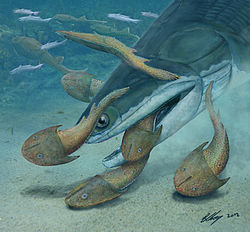 | Megamastax | Megamastax , (big mouth), is a genus of lobe-finned fish which lived during the late Silurian period, about 423 million years ago, in China. Before the discovery of Megamastax, it was thought that jawed vertebrates (gnathostomes) were limited in size and variation before the Devonian period. Megamastax is known only from jaw bones and it is estimated that it reached about 1 metre (3 ft 3 in) long. [30] | ||||
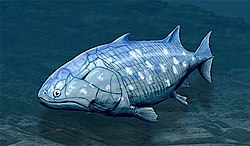 | Guiyu oneiros | Guiyu oneiros , the earliest known bony fish. It has the combination of both ray-finned and lobe-finned features, although analysis of the totality of its features place it closer to lobe-finned fish. [31] [32] [33] | ||||
| Andreolepis | The extinct genus Andreolepis includes the earliest known ray finned fish Andreolepis hedei , which appeared in the late Silurian, around 420 Ma. [34] [35] | |||||



























